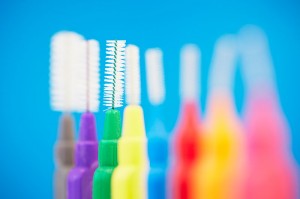Finding Floss Fiddly? Try Interdental Brushes
Daily tooth brushing is an important part of maintaining good oral health. The bristles of a toothbrush are very effective at cleaning accessible areas of the teeth but do not reach interdentally to clean the surfaces where two teeth meet. Dental floss is a common solution and has existed in a similar form for over 200 years when dentists first began recommending silk thread for cleaning between teeth. Some patients are very comfortable using floss but others find it time consuming and somewhat awkward to handle. A 2015 US national survey found that 18% of participants said they would prefer washing a sink full of dishes than flossing their teeth daily. The value of interdental cleaning is still important, so those who feel they can relate to this opinion may be pleasantly surprised by interdental brushes’ ease of use.
Why should I clean interdentally?
Preventing a condition is always preferable to treating it. Dental caries, or tooth decay, is caused by acid from plaque bacteria living on the tooth surface dissolving the tooth’s hard structure. The point of contact of two teeth is a common place for decay to begin because it is not so well cleaned by regular tooth brushing alone, leaving the plaque bacteria behind.
Gingivitis is the technical term for inflamed gums. Gums can become irritated from products released by bacteria living on the nearby teeth. Reducing bacterial numbers by cleaning between the teeth can prevent the onset of gingivitis. Gingivitis may also progress to periodontitis when the bacteria are allowed to mature. Their products then begin to irritate deeper than the gums and onto the tooth’s bone support. Periodontitis is in fact the most common cause of tooth loss in adults.
What are interdental brushes?
Interdental brushes are small brushes that are able to fit between the teeth. As the brush is gently pushed through the space, a correctly sized brush will fill the space to give a superior clean to a thin piece of floss.
Many styles of interdental brushes are available. Some are held between the thumb and forefingers, others have longer handles and right angle heads if the user prefers. The spacing between our teeth varies around our mouths so the size of the bristle heads is important. The largest size that passes through a space comfortably will provide the most effective clean by brushing against the sides.
How do I use interdental brushes?
The use of interdental brushes before or after tooth brushing is open to debate, but as each instrument cleans a different part of the tooth you will see the benefits whichever you favour. Some patients only use interdental brushes as a tool when they have food trapped, but interdental brushing should form part of a daily oral hygiene regime.
Find the size of the interdental brush that fits snugly through the tooth gap and hold it comfortably in your hand.
Enter the brush between the teeth, starting in a logical sequence not to leave any tooth spaces out.
Rinse the brush between insertions as to avoid transferring debris between teeth. You will also see on the bristles what was once being left behind on the teeth after tooth brushing.
Most brands of interdental brushes are reusable so just like a regular toothbrush, keep it on the side and replace it when the bristles begin appearing worn.
Even if using interdental brushes gently and correctly sized, you may still experience some discomfort and/or bleeding when you first begin their use. This can be a sign of sore gums (gingivitis) and you will be benefiting greatly from continuing with the routine. Gingivitis is reversible so once the teeth have had fewer bacteria for several days, the symptoms of inflammation will begin to disappear. If you do remain concerned, please speak with your dentist.
TePe is one of the many interdental brush brands available here in the UK that we as dentists would recommend. Their short YouTube video however gives some insight into the general use of interdental brushes.
If you have any further questions, your dentist or hygienist will be happy to help.
Posted in: General Dentistry
Leave a Comment (0) ↓

